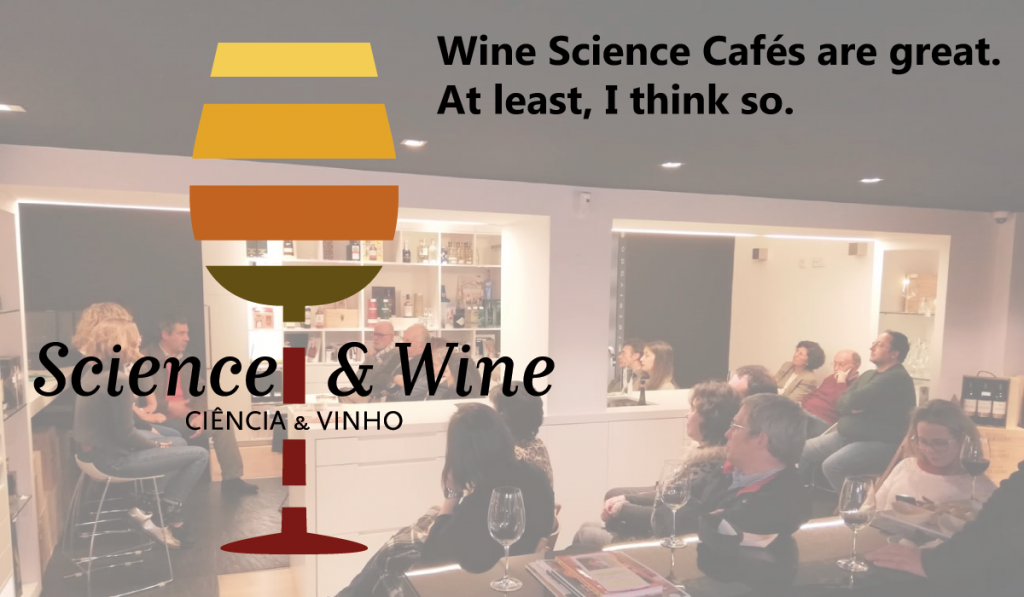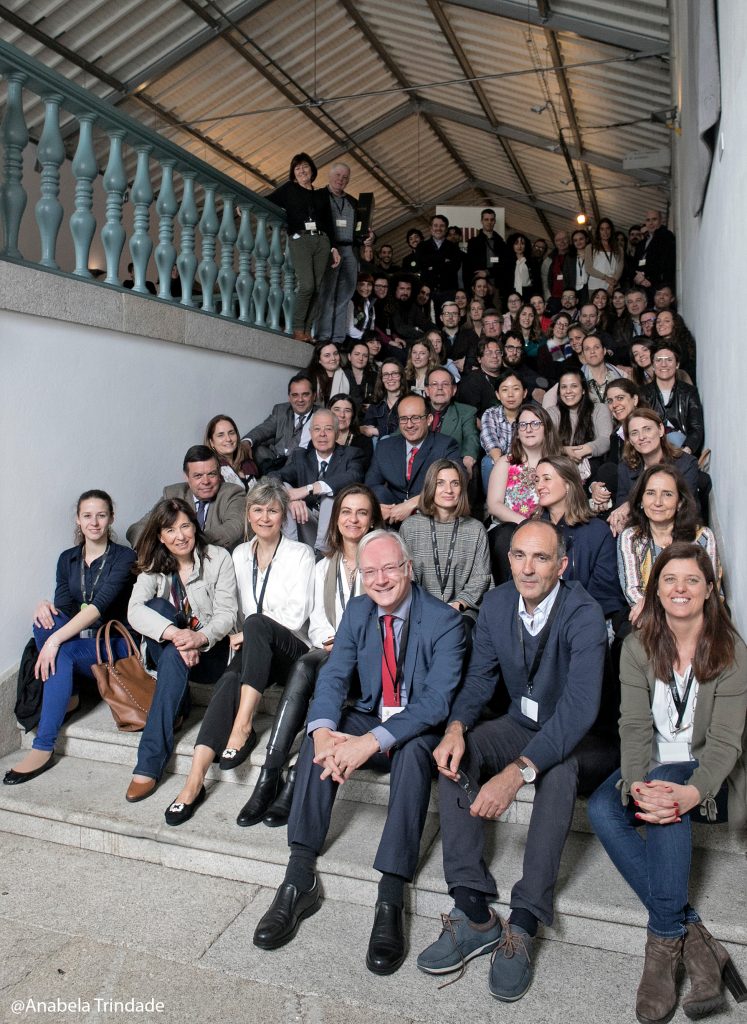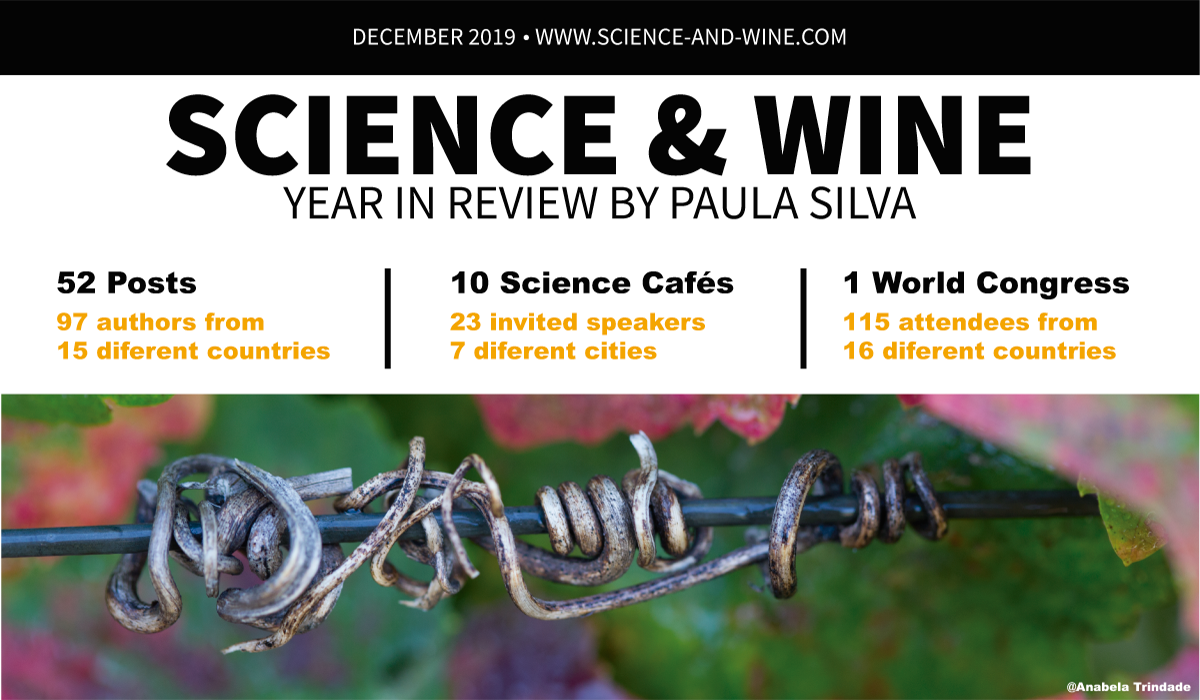By Paula Silva
This is the last post of 2019. The second year of Science & Wine existence, time for a brief reflection. This was a great year! In 2019, as in the first year, we publish a post every Sunday, 52 in total including this one. From these only 6 are of Paula Silva authorship. A total of 97 authors contributed, alone or in co-authoring, with a post. It is important to highlight that we had contributions from all continents except Asia. In the top 3 of post contribution by country are Italy (20 posts), Spain (18 posts) and France (4 posts), which is probably related with the importance of wine production in these countries, since are also the top 3 wine-producing countries. Other interesting fact is that even in the same country the posts are from different academic institutions. A diversity of topics was approached as can be seen in this list below. In conclusion, worldwide researchers are aware of the importance of communicate their scientific results using other ways beyond the classic scientific paper and that it is imperative to share their science with non-academic public. We hope that in 2020 more authors from different parts of the world can contribute with Science & Wine and that beyond posts addressing wine also posts about Mediterranean diet could be published.
Science & Wine organized 10 scientific cafés, which were informal events where scientific information about wine was discussed. These events were carried out in Aveiro, Lamego, Lisboa, Porto, Tabuaço, Vila Nova de Gaia and Vila Real. Several topics were chosen to these discussions, which were always introduced by an academic and a wine professional. This format proved to be very effective to discuss complex issues because people used an informal language and with a familiar environment people “forget” their professional position and speak more openly. We are trying to find a partner(s) to scientific cafés for 2020.

In 2019 occurred the First Science & Wine World Congress in Porto dedicated to discussing “The Wine of the Future” with the support of University of Porto (UPorto) and of International Organization of Vine and Wine (OIV). In the congress were present 115 attendees from 16 different countries, representing 46 universities/research centers, 15 private companies, and 2 public institutes. A total of 74 presentations, 34 oral communications and 40 posters, were presented. The works were divided into the following research areas: wine traceability and authenticity; wine chemistry and sensorial wine experience; wine analysis; vine and wine technology; wine and health and wine waste. A summary of the main conclusions of the congress were published in the 2 scientific journals that were partners of the event, namely Journal of Innovation Management (https://doi.org/10.24840/2183-0606_007.001_0003) and Journal of Agricultural and Food Chemistry (https://doi.org/10.1021/acs.jafc.9b05698). One of the main conclusions was that is necessary to clarify the effects of wine in health, since contradictory messages are often spread by the media. Inspired by this, Science & Wine will promote, in 2020, the Conference “Wine Consumption in the Mediterranean Diet: A clarification about health effects”. Due to the importance of this issue the conference already deserved the institutional support of UPorto, OIV, Chaire UNESCO: Culture et Traditions du Vin, Wine in Moderation – Art de Vivre (WIM), Foundation for Wine and Nutrition Research (FIVIN), Association of Port Wine Companies and Association Nutrition Méditerranéenne et Santé. Among the invited speakers are Francesco Visioli, Lluis Serra-Majem, Monika Christmann, Norbert Latruffe and Ramon Estruch. See more about this conference and the workshop in Quinta do Crasto at https://www.science-and-wine-conferences.com/

But in 2020 we want to do much more. We want to start a project aimed to create a “Science & Wine Tinder – Networking App”, an interaction and event networking app, that takes a new approach to professional networking in scientific wine research area. With this app people can find their perfect “Science and Wine match” by choosing interests they seek and offer. Like the popular dating app, Tinder, they can see their matches and decide if they would like to connect with their match. We also want to launch the “Science & Wine Podcasts” that will give the possibility to share by audio and video the stories of some producers highlighting their relationship with scientific community and vice versa. With this format it will be possible to hear and/or see those testimonials anywhere and anytime. We also would like to organize workshops to companies and scientific community about the importance of communicate effectively with different audiences.
It is also our desire to organize an event dedicated to women named “Women in Science and Wine: The path to progress”. The idea is to promote an event, at March 8th, with the aim of joining the greatest number of women that work with wine, maybe a new Guinness World Record. In an informal environment, these women will be able to share their stories and to give recommendations for the next generations.
All Science & Wine projects have been possible because of the support of our partners, a special word for VIENOL and Quevedo that are with us since the first minute and support all our projects. We hope that the support to our project increases to be possible to materialize all our plans. To all authors, partners, followers and to all that believe in us we want to thank and wish a great 2020.
- Pulsed electric fields accelerate release of mannoproteins from Saccharomyces cerevisiae during aging on the lees of Chardonnay wine
- What percentage of cork should a cork-based stopper have from a mechanical perspective?
- Combining rootstocks and deficit irrigation techniques to maintain vineyard sustainability under semiarid and water limiting conditions
- From grape to wine: a focus on seed tannins
- The beneficial effects of wine polyphenols on Alzheimer’s disease
- New insights about the functionalities of oenological tannins
- Application of ozone during grape drying to produce straw wine. Effects on the microbiota and compositive profile of grapes.
- Epigenetics, environmental responses and viticulture
- Impact of high temperature on red grape flavonoids
- Individual differences and effect of phenolic compounds in the immediate and prolonged in-mouth aroma release and retronasal aroma intensity during wine tasting
- Aging of Aglianico and Sangiovese wine on mannoproteins: effect on astringency and colour
- On the use of Micro-NIRS technology to evaluate wine extractable total phenolic and ellagitannin contents in revalorized cooperage byproducts: a feasibility study.
- On grapevine adaptation to drought: new insights into the genotype-dependent responses to water stress
- The impact of climate change on grapevine phenology and the influence of altitude: a regional study
- Identifying chemical parameters and discriminant phenolic compounds from metabolomics to gain insight into the oxidation status of bottled white wines
- Aiming at grapevines with increased resistance to pathogens, reaching structural genome modifications
- Fingerprinting untargeted analysis as potential tool to classify wine grape biotypes based on their variety and sanitary condition
- Psychological warfare in vineyards: Using drones and bird psychology to control bird damages to wine grapes
- Aromatic evolution of blanc de noirs sparkling wines made by traditional method during twelve months of aging on their lees
- The Biochar challenge in viticulture; enhance grape production and mitigate the effect of climate change in Mediterranean area
- The potential carbon neutrality of sustainable viticulture
- Musical wine glasses
- Irrigation for modulating Godello wine composition under humid conditions
- Lasers, nanoparticles and wine: white wine identification with SERS
- The impact of vineyard agrochemicals against a phytophagous mite and its predator
- Advance of grape harvest date of a premium wine in Central Italy: evidence of the role of precipitation intensity under a warming climate
- Innovative technology using staves and micro-oxygenation and its impact on the phenolic composition and colour of the aged wine spirit
- Wine Science Cafés are great. At least, I think so.
- Wine and Membranes
- A more circular economy model for wine packaging?
- Red grape pomace: a wine by-product with potential health benefits
- How to increase the tannin content of cold-hardy interspecific hybrid grape wines cultivated in cold climate?
- Exploring the diversity of a collection of native non-Saccharomyces yeasts to develop co-starter cultures for winemaking
- Organic and biodynamic wines quality and characteristics: the scientific point of view
- Enological repercussions of non-Saccharomyces species in wine biotechnology
- Mapping the evolution of Chenin Blanc and Sauvignon Blanc wines
- Wine Consumption in the Mediterranean Diet: A clarification about health effects
- Social Media Marketing in promoting Wine Tourism in Langhe, Italy
- Fiano, Greco and Falanghina grape cultivars differentiation by volatiles fingerprinting
- Alcohol use in fatty liver disease
- Mass spectrometry-based metabolomics in grapevine and wine fingerprinting
- How natural do you perceive this wine?
- Interactive effects of the rootstock and the deficit irrigation technique on wine composition, nutraceutical potential, aromatic profile, and sensory attributes under semiarid and water limiting conditions
- Post Nº 100
- How efficient is resveratrol as an antioxidant of the Mediterranean diet, towards alterations during the aging process?
- 2,4,6-trihydroxyphenanthrene: a new trans-resveratrol derivative detected in red wine after UV irradiation.
- Fourteen ethyl esters of wine can be replaced by simpler ester vectors without compromising quality but at the expense of increasing aroma concentration
- Fertility and Wine
- Synergy between HPTLC and HPLC-DAD for the investigation of wine-making by-products
- Development of a new strategy for studying the aroma potential of winemaking grapes through the accelerated hydrolysis of phenolic and aromatic fractions (PAFs)
- This Christmas impress your family and friends with a Mediterranean Diet menu.

